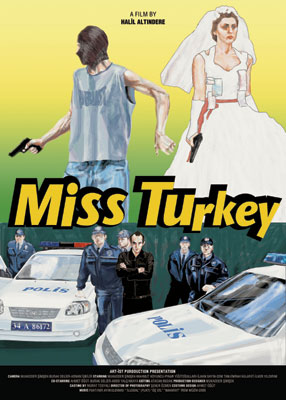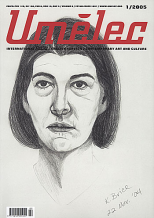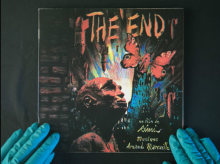| Umělec magazine 2006/1 >> For or About - Or a Question: Who am I? | List of all editions. | ||||||||||||
|
|||||||||||||
For or About - Or a Question: Who am I?Umělec magazine 2006/101.01.2006 Alina Serban | info | en cs |
|||||||||||||
|
I digress upon a pressing question: Who am I? When discussing the most recent Istanbul Biennial, there are manifold reasons to ask. Not only does the question introduce the issue of local identity and critical regionalism; in a deeper sense, it addresses the transgression process of cultural forms, and the borderless situation in which these forms appear and co-exist.
A hallmark of current contemporary cultural dynamics is the phenomenon of the appropriation of ideas, meanings and values from one context to be transferred and received in another. The translation of cultural production seems to be a common method to enter into discourse, in which the idea of relocation is part of a strategy to respond to diverse social eruptions, political disagreements, cultural failures or modifications of urban identities. But it does seem that, after continuous debates about issues local and global, the intellectual game of “moving situations” and “movable concepts” has begun to be somewhat repetitive. Fatigue. Exhaustion. New ways to gaze and problematize the present situations had to develop. This question arose spontaneously after I had diligently followed the itinerary of the 9th International Istanbul Biennial. I was overwhelmed by contradictory emotions. I was frustrated, unable to immediately find any adequate answer to this question. But lingering was a provocation offered by that conceptual frame--a provocation understood within the notion of “shifting identity.” Meandering from one point or another, I accepted a temporary identity, adopting the position of the native. The experience of mapping identity, mapping controversial geographies may very well have been within the script proposed to us by the two curators. It did not seem so much the idea of being mapped per se, as an attempt to engage the works in a dialog with various aspects of the city itself. Istanbul was the theme, and the event was created especially “for” and “about” that city. Trying to observe the new organic structure of the city, the curators proposed alternative meanings to the verb “to experience.” The scenography that was invoked sought to situate art in the city, and to encounter the inner city by creating an interaction point between the two, rather than apply formalist solutions to some local or (g)local issues. As such, the verb “to experience” appears appropriate for the entire site of the biennial, with the curators seeking action and reaction from the public and local community. But the interaction, of the sort that was desired, did not reach the intended dimensions. Characteristic of the event in its entirety was a lack of aggressiveness, a subtle balance between the idea of “being in situ” and “acting in situ.” In some parts of the whole show two parts seemed to be finding the adequate reciprocity, and determining the inner experience of the city. Considering the large number of biennials, one must take into account curatorial ethical statements and to inquire about the real potential for any biennial to be a generator of attitudes that might influence social contexts. It is then inevitable to ask whom the curator is addressing today, and, most importantly, what is the relevance of the curatorial gesture. Perhaps such questions are perceived as simplistic, but they need to be put forward in order to distinguish theoretical approaches, practices, and the intrinsic logic of choosing cultural perspectives and the artworks associated. Curatorial discourse can also be a direct consequence of issues raised by a context. Indeed, locality seems to be an important aspect of discourse production. Istanbul, as such, is a vivid place confronted with diverse political, social, ethnical, and urban issues. The difficult aspect of the curatorial proposition is the interest for creating new venues intermingled within the city fabric, presenting to the viewer a nervous attempt to separate such venues from the urban context. There is also a risk taken to present new, less known, artistic positions. Another suggestion worked with by curators was to pay attention to contrasting situations, bringing works into the biennial context that don’t directly address the theme proposed. Many of them worked toward an answer to the question: Jakup Ferri’s videos, Phil Collins’ re-recorded pieces after The Smiths 1987 album The World Won’t Listen, Ola Perhson’s Hunt for the Unabomber, and Serkan Ozkaya and David Malijković’s video installation Scene for a New Heritage. Renegotiating the terms where culture and urban structure cross - Topography, Context, Light and Tectonic Form - some pieces are able to inscribe the character of the city, to stress the ambiguity between "opened" and "closed" regionalism. Such is the case of Halil Altindere’s video Miss Turkey, the work of Karl-Heinz Klopf, Mind the Steps and Nedko Solakov’s installation Art &Life (in my part of world). In some cases the challenge to the artist was a success – the work having the capacity to incorporate in its vision the intimate identity of the city and tradition, but there are examples where long quotations or simply visual documentation of the urban existence did not succeed in offering to the viewer awareness of the inner city. On the contrary it seems that some pieces are perpetuating these clichés and couldn’t escape the general perspective. Some artists were focusing on describing the current state of destruction of traditional culture, others are renegotiating a past (the video Billboard Istanbul Biennial 1995 of Maria Eichhorn) and some interesting pieces are talking about the idea of cultural appropiation and resistance (Yael Bartana’s video, Wild Seeds), about political and social changes suffered by the city (Dan Perjovschi, Istanbul Drawing). If “for” and “about” suggests the causal relations constructed between the art response and the city’s new urbanity and social life, the questions of “who” and “about” seem to be the main point which the curators wanted to emphasize. The idea is that we are not dealing with an abstract notion of context, but with a particular dynamic one, thus the personal or individual form of reaction being the approach desired. In this way the notion of “shifting identity” provokes us to better understand the paradigmatic processes which are produced today inside a “planetary city”, as the curators suggested.
01.01.2006
Recommended articles
|
|||||||||||||
|
04.02.2020 10:17
Letošní 50. ročník Art Basel přilákal celkem 93 000 návštěvníků a sběratelů z 80 zemí světa. 290 prémiových galerií představilo umělecká díla od počátku 20. století až po současnost. Hlavní sektor přehlídky, tradičně v prvním patře výstavního prostoru, představil 232 předních galerií z celého světa nabízející umění nejvyšší kvality. Veletrh ukázal vzestupný trend prodeje prostřednictvím galerií jak soukromým sbírkám, tak i institucím. Kromě hlavního veletrhu stály za návštěvu i ty přidružené: Volta, Liste a Photo Basel, k tomu doprovodné programy a výstavy v místních institucích, které kvalitou daleko přesahují hranice města tj. Kunsthalle Basel, Kunstmuseum, Tinguely muzeum nebo Fondation Beyeler.
|

































 We Are Rising National Gallery For You! Go to Kyjov by Krásná Lípa no.37.
We Are Rising National Gallery For You! Go to Kyjov by Krásná Lípa no.37.
Comments
There are currently no comments.Add new comment